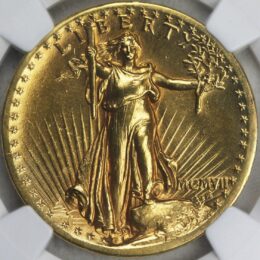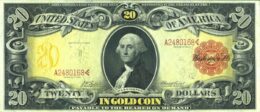The Future of Freedom Foundation
November 12, 2025
For more than 125 years, the United States had a gold-coin, silver-coin monetary system. No, it was not a paper-money system backed by gold, as so many mainstream commentators have been taught to believe. It was a system in which gold coins and silver coins were the official money of the American people.
Yes, there were paper bills and notes and other debt instruments issued by the federal government. And yes, oftentimes people would use them as a convenient way to pay for things. But everyone understood that these were nothing more than promises to pay money, not money themselves. The money that these debt instruments were promising to pay consisted of gold coins and silver coins, which, again, were the official money - or "legal tender"- of the American people for more than a century.
How did this gold-coin/silver-coin monetary system come into being? It came with the Constitution, the document that called the federal government into existence. The Constitution gave the federal government the power to coin money but not the power to print money. Everyone understood that coining money meant gold coins and silver coins.
At the same time, the Constitution expressly prohibited the states from making anything but gold coins and silver coins legal tender or official money. State banks would oftentimes issue bills and notes but, again, everyone understood that these were debt instruments that were promising to pay money - that is, promising to pay gold coins and silver coins.
Once the Constitution was ratified and the federal government came into existence, the federal government began issuing gold coins and silver coins. Those coins became the official money of the United States and continued being such for more than a century. The stability they afforded in terms of value was a major factor contributing to the enormous increase in the overall standard of living of the American people in the late 1800s.
Why did the Framers adopt a gold-coin, silver-coin standard and reject a paper-money standard? Because they knew that with a paper-money standard, federal officials would inevitably begin inflating the amount of paper money in circulation by simply using a printing press to print any amount of paper money they wanted, in order to pay for their ever-growing expenditures. The Framers knew that that is what regimes had done ever since Gutenberg invented the printing press.
While it was possible to debase the value of gold coins and silver coins by surreptitiously and fraudulently reducing their gold and silver content, that never happened with U.S. coins. America's gold coins and silver coins were among the most honest and reputable coins in world history.
This remarkable constitutional monetary system came to an abrupt end in the 1930s. Using the Great Depression as an excuse, President Franklin Roosevelt decreed a permanent end to America's gold-coin, silver-coin monetary system. He ordered that it be replaced with a paper-money system - the very system that the Framers and our American ancestors had rejected. FDR did this without even the semblance of a constitutional amendment.
Thus, for some 90 years, Americans have lived under the paper-money system that FDR established. When we examine what his paper-money system has done to the value of people's money, we can understand why the Framers and our American ancestors were so ardently opposed to a paper-money system and why they chose instead a gold-coin/silver coin monetary system.

1907 St. Gauden's $20 coin. Licensed under the GNU Free Documentation License and the Creative Commons Attribution-Share Alike 3.0 Unported license.
Thus, the two items - the $20 gold coin and the $20 paper gold certificate were interchangeable in terms of value. If someone went into a store and was going to purchase something that cost twenty dollars, the store owner would be willing to receive in payment either the $20 gold coin or the $20 gold certificate.
After FDR placed the United States on a paper-money standard, the federal government no longer was bound to exchange its gold certificates - or, for that matter, its bills and notes - for gold coins. Americans were ordered to surrender their gold coins and their gold certificates to the federal government. They received $20 bills in exchange. Those $20 bills were decreed to be the new official money in and of themselves. While they continued promising to pay money, the only thing the federal government would give people on demand was just paper money.

1905 $20 Gold Certificate
The federal government proceeded to do what the Framers said it would do if the Constitution had established a paper-money system. Decade after decade, the federal government printed ever-growing quantities of paper money, thereby enormously inflating the overall quantity of paper money in circulation.
Over time, increasing the supply of paper money naturally decreased its value. We can easily see the consequences of FDR's paper-money system by comparing the value of a paper $20 bill today to the current value of a $20 St. Gauden's one-ounce gold coin under the gold-coin/silver coin system.
Remember: Under the gold-coin, silver coin standard, a $20 St. Gauden's gold coin and a $20 gold certificate (or a $20 bill) were interchangeable in terms of value. Not so today. Today, it takes about $4,300 to purchase a $20 St. Gauden's gold coin. In other words, to purchase the St. Gauden's $20 gold coin, a person needs to pay around 215 $20 bills rather than simply one $20 bill.
That means that if a family held onto a St. Gauden's $20 gold coin, it could sell it today for more than $4,000 and then buy something that costs $4,000.

2006 $20 Federal Reserve Note.
Here is an example of a $20 bill today. Notice that it still has the trappings of a promise to pay. It's called a "Federal Reserve Note." A note is a promise to pay. But notice something else: It doesn't promise to pay anything. Instead, it decrees on its face that it - the paper note itself - is legal tender or official money.
Today, that $20 paper bill can be used to purchase a couple of packs of cigarettes. Today, that $20 St. Gauden's gold coin can be used to purchase something that costs around $4,000 in paper money. In other words, if someone offered you a choice between a $20 bill and a $20 St. Gauden's gold coin, which would you choose?
That's what the federal government and the much-vaunted paper-money system that FDR foisted onto the American people have done to our money.
Reprinted with permission from Future of Freedom Foundation.